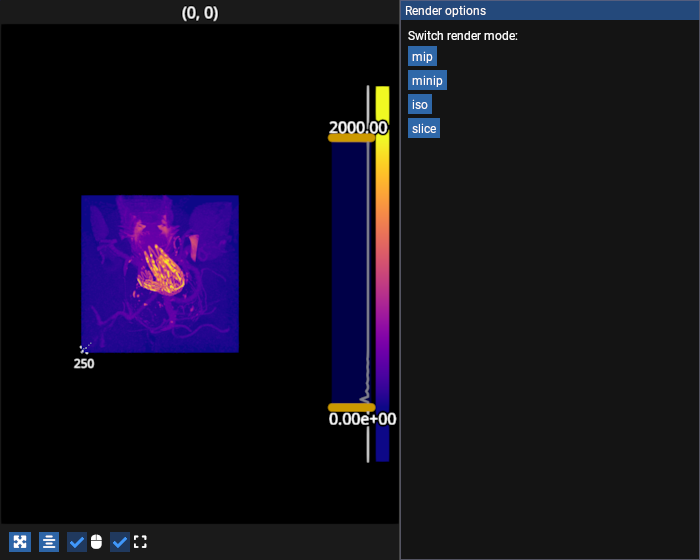Note
Go to the end to download the full example code.
Volume modes#
View a volume using different rendering modes.

/opt/hostedtoolcache/Python/3.12.12/x64/lib/python3.12/site-packages/pygfx/objects/_ruler.py:400: RuntimeWarning: divide by zero encountered in divide
screen_full = (ndc_full[:, :2] / ndc_full[:, 3:4]) * half_canvas_size
/opt/hostedtoolcache/Python/3.12.12/x64/lib/python3.12/site-packages/pygfx/objects/_ruler.py:400: RuntimeWarning: invalid value encountered in divide
screen_full = (ndc_full[:, :2] / ndc_full[:, 3:4]) * half_canvas_size
/opt/hostedtoolcache/Python/3.12.12/x64/lib/python3.12/site-packages/pygfx/objects/_ruler.py:412: RuntimeWarning: invalid value encountered in divide
screen_sel = (ndc_sel[:, :2] / ndc_sel[:, 3:4]) * half_canvas_size
/home/runner/work/fastplotlib/fastplotlib/fastplotlib/graphics/features/_base.py:18: UserWarning: casting float64 array to float32
warn(f"casting {array.dtype} array to float32")
# test_example = true
import numpy as np
import fastplotlib as fpl
from fastplotlib.ui import EdgeWindow
from fastplotlib.graphics.features import VOLUME_RENDER_MODES
import imageio.v3 as iio
from imgui_bundle import imgui
voldata = iio.imread("imageio:stent.npz").astype(np.float32)
figure = fpl.Figure(
cameras="3d",
controller_types="orbit",
size=(700, 560)
)
figure[0, 0].add_image_volume(voldata, name="vol-img")
# add an hlut tool
hlut = fpl.HistogramLUTTool(voldata, figure[0, 0]["vol-img"])
figure[0, 0].docks["right"].size = 80
figure[0, 0].docks["right"].controller.enabled = False
figure[0, 0].docks["right"].add_graphic(hlut)
figure[0, 0].docks["right"].auto_scale(maintain_aspect=False)
class GUI(EdgeWindow):
def __init__(self, figure, title="Render options", location="right", size=300):
super().__init__(figure, title=title, location=location, size=size)
# reference to the graphic for convenience
self.graphic: fpl.ImageVolumeGraphic = self._figure[0, 0]["vol-img"]
def update(self):
imgui.text("Switch render mode:")
# add buttons to switch between modes
for mode in VOLUME_RENDER_MODES.keys():
if imgui.button(mode):
self.graphic.mode = mode
# add sliders to change iso rendering properties
if self.graphic.mode == "iso":
_, self.graphic.threshold = imgui.slider_float(
"threshold", v=self.graphic.threshold, v_max=255, v_min=1,
)
_, self.graphic.step_size = imgui.slider_float(
"step_size", v=self.graphic.step_size, v_max=10.0, v_min=0.1,
)
_, self.graphic.substep_size = imgui.slider_float(
"substep_size", v=self.graphic.substep_size, v_max=10.0, v_min=0.1,
)
_, self.graphic.emissive = imgui.color_picker3("emissive color", col=self.graphic.emissive.rgb)
if self.graphic.mode == "slice":
imgui.text("Select plane defined by:\nax + by + cz + d = 0")
_, a = imgui.slider_float("a", v=self.graphic.plane[0], v_min=-1, v_max=1.0)
_, b = imgui.slider_float("b", v=self.graphic.plane[1], v_min=-1, v_max=1.0)
_, c = imgui.slider_float("c", v=self.graphic.plane[2], v_min=-1, v_max=1.0)
largest_dim = max(self.graphic.data.value.shape)
_, d = imgui.slider_float("d", v=self.graphic.plane[3], v_min=0, v_max=largest_dim * 2)
self.graphic.plane = (a, b, c, d)
gui = GUI(figure=figure)
figure.add_gui(gui)
figure.show()
# NOTE: fpl.loop.run() should not be used for interactive sessions
# See the "JupyterLab and IPython" section in the user guide
if __name__ == "__main__":
print(__doc__)
fpl.loop.run()
Total running time of the script: (0 minutes 0.751 seconds)
